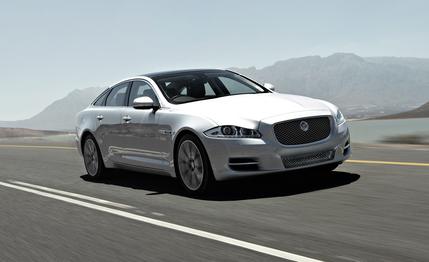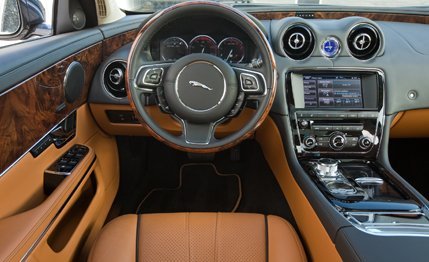
 Instrumented Test
Instrumented Test




In the game of U.S. luxury-car sales, Jaguar isn’t even on the sidelines. It’s behind the bench, next to the water cooler, and maybe lying down because it ate something funny. Frankly, the brand gets its butt kicked over here, moving just 5 percent of what either BMW or Mercedes sells and doing only 10 percent of Audi’s volume. Jaguar—the entire brand—is outsold by both the Porsche Cayenne and Lexus’s CT200h hybrid hatchback. (The CT200h, people—you probably forgot that car even exists.)
While the Germans would have to completely cease operations for, oh, a decade before Jaguar could close that sales gap, this model year brings a major revamp of the British brand’s portfolio that should help. As part of its plan to catch up, Jag says it will introduce 40 new vehicles and technologies by 2016. The XF and XJ start it off with a new eight-speed automatic, available all-wheel drive, and smaller, more fuel-efficient engines. The new base XJ, tested here, is powered by the 3.0-liter supercharged V-6 derived from Jaguar’s excellent 5.0-liter V-8.
With 340 horsepower and 332 pound-feet of torque, the direct-injected six gives up 130 horses and 92 pound-feet to the next-step-up short-wheelbase car, the V-8 XJ Supercharged. It’s a large power disparity, V-6 to V-8, but the difference in performance is much smaller. The rear-drive V-6 XJ trails its blown-eight analogue (tested with a six-speed auto) to 60 mph by a measly 0.8 second, and to the quarter-mile mark by just one second. The V-8 pulls away more smartly at extra-legal speeds, but bruised egos can be iced by the pile of cold, hard cash saved by opting for the six: It’s 16 grand—or one Honda Fit—cheaper. The base price of $74,075 is roughly in line with six-cylinder versions of the 7-series and A8, although the latter includes all-wheel drive, a $3500, V-6–only option on the Jag. At the scales, the XJ V-6 carries less weight up front than the V-8 (50.5 percent versus 51.1), and overall weight is down 116 pounds.


The new six feels strong, willing, and smooth in operation. This XJ also returned better fuel mileage in our hands, 18 mpg versus the supercharged SWB car’s 16. We have no doubt the improvement will be greater for those who drive with less urgency and who don’t turn off the engine stop-start system as often as we did—it sends shudders through the car with every startup. We also had an issue with the short but frustrating delay before the transmission kicks down after full-throttle requests, which is the case even when the car’s chassis-enlivening Dynamic mode is enabled.
The rest of the experience is familiar XJ, which means taut styling, athletic responses, supple leather, gorgeous wood, great seats, and an infuriating infotainment system. The car is the sportiest and lightest in the segment, and outside of oak interior trim and an adaptive differential, every major standard feature sacrificed from the XJ Supercharged can be added back for $11,000 or so—a veritable deal that leaves enough change for a lifetime supply of Bovril.
It might be a long time before Jaguar finds itself in the U.S. luxury market’s starting lineup, but if the V-6 XJ is a sign of things to come, then the company has a chance to at least see the field.